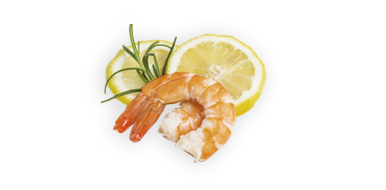

Healthy Eating

Eating Seafood
1What is healthy eating?
According to Dietary Guidelines for Americans 2015-2020 8th Edition, we should make sure to nourish our bodies with a variety of healthy foods including:
• Vegetables of all kinds and colors—dark green, red and orange; legumes (beans and peas), starchy vegetables, and others
• Fruits, especially whole fruits
• Grains, at least half of which are whole grains
• Fat-free or low-fat dairy, including milk, yogurt, cheese, and/or fortified soy beverages
• A variety of protein foods, including seafood (That’s US!), lean meats and poultry, eggs, legumes (beans and peas), and nuts, seeds, and soy products. Of course, we recommend Pier 33 Gourmet Ocean Raised™ Seafood
• Healthy oils
2What are Omega-3 fatty acids and why are they part of healthy eating?
Seafood is the richest source of Omega-3 fatty acids, which may be helpful in the prevention and treatment of:
• Heart disease
• High blood pressure
• Inflammation
• Mental health disorders
• Diabetes
• Digestive disorders
• Autoimmune disease
• Cancer
3How can our products help with weight loss?
Our Pier 33 Gourmet Ocean Raised™ Atlantic Salmon, wild caught Langostino Lobster Tails and rope-cultured Mussels are high in protein, low in fat and very low in carbohydrates.
4Where can I find healthy, quick and easy recipe ideas?
Visit our
'In a Heartbeat Recipe Collection'
5What is a Mediterranean-Style diet?
The Healthy Mediterranean-Style Eating Pattern contains more fruits and seafood and less dairy than does the Healthy U.S.-Style Eating Pattern.
6How can I make Pier 33 Gourmet part of my glutten-free diet?
The Pier 33 Gourmet Seafood Products that don’t have sauces are gluten-free.
1What are the nutritional benefits of consuming seafood?
Health conscious eaters, according to the University of Michigan, should choose seafood because it:
• Is low in saturated fat
• Is a rich source of protein and iron
• Contains B vitamins, including B-12
• Promotes normal fetal growth and child development
• Is The richest source of Omega-3 fatty acids
2How do I make smart seafood choices?
The U.S. Department of Health Dietary Guidelines tell us to select seafood higher in EPA and DHA and lower in methyl mercury. In the United States, that includes Ocean Raised™ Atlantic Salmon (We agree!), anchovies, herring, shad, sardines, Pacific oysters, trout, and Atlantic and Pacific mackerel (But not king mackerel, which is high in methyl mercury). Consumers can make healthy and sustainable food choices by choosing fish that is sourced sustainably and low in mercury.
3What are the health benefits of consuming seafood?
In a word, Omega-3! Omega-3 fatty acids are good for brain and eye development, and also boost heart health in all age groups. With two servings a week, you can usually get at least 1,750 milligrams of EPA and DHA. The fish with the most Omega-3? Salmon (like Pier 33 Gourmet Ocean Raised™ Atlantic Salmon), mackerel, herring, sardines, anchovies, trout, and tuna.
Source
4What are the nutritional and health benefits of eating salmon?
Salmon is rich in Omega-3, Protein, and Vitamins A, B12 and D. Based on the “USDA Nutrition Database,” Ocean Raised™ Farmed Atlantic Salmon has among the highest Omega-3 content of all salmon. According to scientific reports, Omega-3 fatty acids may help reduce the risk of heart attacks and drive down LDL (bad) cholesterol. Pier 33 Gourmet Ocean Raised™ Farmed Atlantic Salmon is also a great source of Protein and Vitamins A, B12 and D.
5What are the nutritional and health benefits of eating mussels?
Fitness magazine has reported that shellfish like mussels, clams, and oysters are loaded with minerals and high in protein. Specifically, mussels are high in iron and selenium (which is also known to play a key role in metabolism).
6What are the nutritional and health benefits of eating langostino lobster?
Livestrong.com tells us that langostinos contain zero carbohydrates and provide you with 21 grams of protein per serving. Protein is important to meet energy needs and promotes muscle building. Protein also helps protect your immune system. A 4-oz. portion of langostino lobster contains 1 gram of fat, which makes this shellfish a good choice for low-fat diets. Rich in minerals, langostinos contain calcium and iron. A 4-oz. serving provides 8 percent of the daily, recommended intake of calcium, a mineral your body uses to strengthen your bones and teeth. A serving of langostino contains 8 percent of the iron your body needs each day.
7Why is consuming seafood good for your heart health?
The smart people at Health.gov tell you to nourish your heart by consuming about 8 ounces per week of a variety of seafood, which provide an average of 250 mg per day of EPA and DHA. These nutrients are associated with a lower risk of cardiac deaths among individuals with and without pre-existing cardiovascular disease (CVD).
8Why is consuming seafood good for pregnant women?
While seafood may not be a baby’s first choice of what to eat women who are pregnant or breastfeeding, according to Health.gov, should consume at least 8 and up to 12 ounces of a variety of seafood per week. Future moms should make sure to choose varieties that are lower in methyl mercury and are good sources of DHA, which is associated with improved infant health outcomes. Ask your obstetrician and pediatrician about how to make healthy food choices that include seafood.
9Where do Wild Argentine Red Shrimp Come From?
Wild Argentine Red Shrimp are cold water shrimp, unlike most of the shrimp in the market today. They are caught in the ocean waters off the coast of Argentina as far south as the Argentine Patagonia.
10Wild Argentine Red Shrimp tastes different than the most known varieties?
The taste and texture of this uniquely delicious shrimp if often compared to that of lobster, yes lobster!
11What is the best way to cook Wild Argentine Red Shrimp?
Argentine Red Shrimp cook extremely fast. For the best results, it is best to grill or sauté them 2-3 minutes per side.
